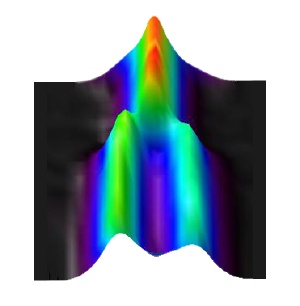Nov 13 2008
Researchers at the National Institute of Standards and Technology (NIST) are decoding the mysterious mechanisms behind the high-temperature superconductors that industry hopes will find wide use in next-generation systems for storing, distributing and using electricity. In two new papers* on a recently discovered class of high-temperature superconductors, they report that the already complicated relationship between magnetism and superconductivity may be more involved than previously thought, or that a whole new mechanism may drive some types of superconductors.
 NIST researchers have found that new iron-based high-temperature superconductors subtly change their molecular shape as temperatures decrease. This graphic shows a superconductor transitioning from tetragonal (at top) to orthorhombic at about 220 Kelvin (-53 Celsius). Such physical changes appear to be a precursor to superconductivity, in which electric current can flow without resistance. Credit: NIST
NIST researchers have found that new iron-based high-temperature superconductors subtly change their molecular shape as temperatures decrease. This graphic shows a superconductor transitioning from tetragonal (at top) to orthorhombic at about 220 Kelvin (-53 Celsius). Such physical changes appear to be a precursor to superconductivity, in which electric current can flow without resistance. Credit: NIST
At temperatures approaching absolute zero, many materials become superconductors, capable of carrying vast amounts of electrical current with no resistance. In such low-temperature superconductors, magnetism is a villain whose appearance shatters the fragile superconductive state. But in 1986, scientists discovered "high temperature" (HTc) superconductors capable of operating much warmer than the previous limit of 30 degrees above absolute zero. In fact, today's copper-oxide materials are superconductive in liquid nitrogen, a bargain-priced coolant that goes up to a balmy 77 degrees above absolute zero. Such materials have enabled applications as diverse as high-speed maglev trains, magnetic-resonance imagers and highly sensitive astronomical detectors. Still, no one really understands how HTc superconductivity works, although scientists have long suspected that in this case, magnetism boosts rather than suppresses the effect.
The beginnings of what could be a breakthrough came in early 2008 when Japanese researchers announced discovery of a new class of iron-based HTc superconductors. In addition to being easier to shape into wires and otherwise commercialize than today's copper-oxides, such materials provide scientists fresh new subjects with which to develop and test theories about HTc superconductivity's origins.
Scientists at NIST's Center for Neutron Research and a team including researchers from the University of Tennessee at Knoxville, Oak Ridge National Laboratory, the University of Maryland, Ames Laboratory and Iowa State University used beams of neutrons to peek into a superconductor's atomic structure. They first found iron-based superconductors to be similar to copper-oxide materials in how "doping" (adding specific elements to insulators in or around a HTc superconductor) influences their magnetic properties and superconductivity.
Then the team tested the iron-based material** without doping it. Under moderate pressure, the volume of the material's crystal structure compressed an unusually high 5 percent. Intriguingly, it also became superconductive without a hint of magnetism.
The iron-based material's behavior under pressure may suggest the remarkable possibility of an entirely different mechanism behind superconductivity than with copper oxide materials, NIST Fellow Jeffrey Lynn said. Or it could be that magnetism is simply an ancillary part of HTc superconductivity in general, he said-and that a similar, deeper mechanism underlies the superconductivity in both. Understanding the origin of the superconductivity will help engineers tailor materials to specific applications, guide materials scientists in the search for new materials with improved properties and, scientists hope, usher in higher-temperature superconductors.
* J. Zhao, Q. Huang, C. de al Cruz, S. Li, J. W. Lynn, Y. Chen, M. A. Green, G. F. Chen, G. Li, Z. C. Li, J. L. Luo, N. L. Wang and P. Dai. Structural and magnetic phase diagram of CeFeAsO1-xFx and its relationship to high-temperature superconductivity. Nature Materials (DOI 10.1038/nmat2315).
A. Kreyssig, M. A. Green, Y. B. Lee, G. D. Samolyuk, P. Zajdel, J. W. Lynn, S. L. Bud'ko, M. S. Torikachvili, N. Ni, S. Nandi, J. Leão, S. J. Poulton, D. N. Argyriou, B. N. Harmon, P. C. Canfield, R. J. McQueeney and A. I. Goldman. Pressure-induced volume-collapsed tetragonal phase of CaFe2As2 as seen via neutron scattering. Phys. Rev. B 78 (in press).
** CaFe2As2